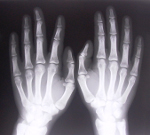Osteoarthritis: A Basic Introduction
Author: tiger Published Under: Health

A common misconception about arthritis is that it is an elderly disease, only affecting seniors, but tis is not actually the case. Arthritis can be found in people of any age, including children. However, there is some truth to this misconception, as arthritis is more common in seniors. There are quite a few different types of arthritis, but in seniors, osteoarthritis is the most common kind.
Basic Characteristics of Osteoarthritis?
Osteoarthritis is classified as a type of degenerative arthritis, which most often manifests as a monoarthritis, meaning it only affects a single joint, or a oligoarthritis, meaning it affects less than five joints.
The most common joint affect by osteoarthritis is the base of the thumb or the tips of the fingers, although hip and knee osteoarthritis is also common, with the latter, the knee, being more common than the hip.
It is believed that there are more than 20 million Americans with osteoarthritis, although many of these people have not been officially diagnosed with the disease. Osteoarthritis affects a significant portion of the elderly, with most estimates suggesting that between ten and twenty percent of seniors are significantly affected by osteoarthritis.
Who Can Get Osteoarthritis?
Osteoarthritis, like other types of arthritis is not limited to a specific age group, however it is the most common in those over the age of forty, with most seniors over sixty-five exhibiting some signs of the disease.
Osteoarthritis is also more common in females, with hip and hand osteoarthritis being the most common type of arthritis found in women. In addition to gender, a persons genetics can also increase the chance of developing osteoarthritis, however genetics is thought to be most closely related to hand arthritis and to a lesser degree knee and hip osteoarthritis. Some studies indicate that in those with osteoarthritis, a gene related to the development of vitamin D is not present or working properly.
Another factor that has been linked to osteoarthritis is obesity, which is believed to be because of more weight and pressure being put on the joints, resulting in significantly more wear and tear. Those who are classified as obese are most likely to develop knee osteoarthritis.
Injury and repetitive actions can also increase the chance that osteoarthritis will occur at a later time. Soccer is one profession that has been found to often cause osteoarthritis of the knee.
How Osteoarthritis Affects the Body
Often, the first symptoms of osteoarthritis go unnoticed for some time, with the disease developing over the course of many years. Most often, it is caused by cartilage in the joint breaking down, which causes the bones to directly rub against one-another. In a healthy joint, the cartilage acts as a buffer, protecting the bones in the joint, however in those with osteoarthritis the cartilage wears away and the bones begin to directly wear on each other.
Often, osteoarthritis causes swelling of the joint and it is also possible for fluids to begin to build up on the joint. Small pieces of bone or cartilage may also break off and float around the synovial fluid in the joint, causing discomfort and swelling. Osteophytes, which are bone spurs, may also form on the ends of the bones, with the joint itself becoming deformed.